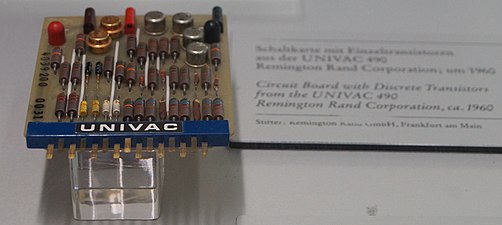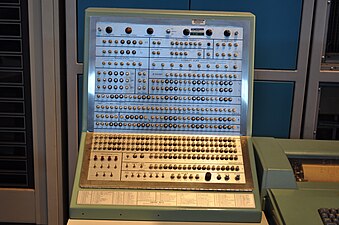UNIVAC 490

TheUNIVAC 490was a 30-bit wordmagnetic-core memorymachine with 16K or 32K words; 4.8microsecondcycle time made byUNIVAC.It was a commercial derivative of theinstruction setthat had been developed for theAN/USQ-17bySeymour Crayfor the US Navy. This was the last machine that Cray designed before leaving UNIVAC to join the earlyControl Data Corporation.
Univac Federal Systems would further developed this system into theAN/USQ-20for theUnited States Navy.That system was the heart of theNaval Tactical Data Systemwhich pioneered the use of shipboard computers forair defense.The military version went by a variety of names:UNIVAC 1232,[1]AN/USQ-20,MIL-1206andCP642.
Overview[edit]
At least 47 of these machines were made (serial numbers run from 101 to 147). Six were installed atNASAand played important roles inGeminiand theApollomissions. The U490 had complete control of most or all of the data readout screens inHouston Mission Control.TheUSAFhad two installed, as didLockheed.[2]
Airlines using the 490 Real-Time system includedEasternandNorthwest Orient– principallyairlinereservations systems atEastern Air Lines(1963) andBritish European Airways(BEACON – 1964).[3][4][5]Other commercial installations of the 490 Real-Time included two atWestinghouse,and one each atAlcoa,U.S. Steel,Bethlehem SteelandGeneral Motors.[2]
The only surviving, nearly complete, original, civilian version of the 490 Real Time System is on display at System Source inHunt Valley, Maryland.It has six banks of memory cores. System Source also has a nearly complete set of original documentation for the machine, including original blueprints and troubleshooting data. This includes the Boss and Wilen document.[2]
The standard Operating System was REX (RealTime Exec), except at Eastern and B.E.A. where a custom operating system was developed for airline reservations (CONTORTS – CONTrol Of Real Time System). CONTORTS was the origin of Univac's subsequent RT operating systems for 494 (STARS) and later converted to the1100 Series(RTOS).
-
A circuit board from the UNIVAC 490 computer on display at theDeutsches Museum
-
The Univac 1232 was a military version of the UNIVAC 490.
-
A Univac 1232 at theSmithsonianNational Air and Space Museum
Architecture[edit]
| Computer architecture bit widths |
|---|
| Bit |
| Application |
| Binary floating-pointprecision |
| Decimal floating-pointprecision |
The instruction word format:
- f – Function code designator (6 bits)
- j – Branch condition designator (3 bits)
- k – Operand-interpretation designator (3 bits)
- b – Operand address modification designator (3 bits)
- y – Operand designator (15 bits)
Numbers were represented inones' complement.
The machine provided the programmer with the followingregisters:
- Seven B-registers (Address modifyingindex registers) 15 bits each
- One A-register or accumulator 30 bits
- One Q-register and auxiliary arithmetic register 30 bits
Hardware[edit]
Construction (Arithmetic unit only)[6]
- Type Quantity
- Diodes 37,543 All types
- Transistors 13,819 All types
Successor Systems[edit]
In June 1965 UNIVAC launched a family of successor systems known as the UNIVAC 490 Modular Real Time Systems. This consisted of the UNIVAC 491, 492 and 494.[7]The 494 was heavily used by NASA as part of the communications complex for the Apollo Mission.[8]Other users include BEA,Iberia Airlines,[9][10]Scandinavian Airlines[11]andLufthansa.[12]
Subsequently as UNIVAC decided to focus on theUNIVAC 1100/2200 seriesan option to run the 1110/80 in 494 mode was added. This emulator was implemented using microcode.
See also[edit]
References[edit]
- ^"Computer, UNIVAC 1232".
- ^abcUnivac 490 Failure Finding by L. D. Boss and J. G. Wilen, August 10, 1964.
- ^Knight, Michael (Summer 2008)."Beacon 1963-7: A System Design Ahead of its Time?"(PDF).Resurrection - the Journal of the Computer Conservation Society(43): 24–33.Retrieved8 May2024.
- ^Yardley, Christopher B. (30 April 2019).Also Innovators: How one computer salesman contributed to the digital revolution.ANU Press. pp. 24, 27.ISBN978-1-76046-299-4.Retrieved8 May2024.
- ^Mayes, Phil (5 January 2016)."Univac 494s at BEA".Retrieved8 May2024.
- ^UNIVAC 490 Real-Time System
- ^Digital Computer Newsletter.Office of Naval Research, Mathematical Sciences Division. 1966. p. 24.
- ^Astronautics, United States Congress House Committee on Science and (1967).Hearings.Retrieved8 May2024.
- ^International Commerce.Bureau of International Commerce. 1968.
- ^Garcia, Pedro."On the origins of the Airline's Electronic Reservations Systems. A grandfather's story (Part I)".Retrieved8 May2024.
- ^Computerworld.IDG Enterprise. 15 January 1979. p. 84.
- ^Kuglin, Bernd; Thielmann, Heinz (15 August 2005).The Practical Real-Time Enterprise: Facts and Perspectives.Springer Science & Business Media. p. 86.ISBN978-3-540-27367-7.



